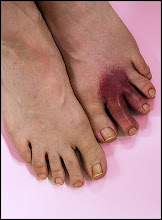Problems of Scale
View PhotoYour Colorado landscapes have a problem, or evince a problem, or beg a question, or exemplify a quandary, or like that, which I've been agonizing over myself. In the 70's I used big-negative equipment (Rollei, 4x5) to do landscapes, and even then seldom printed bigger than 8x10. The impact of my photos, assuming they had any (and if they did it was on me alone, absent the Internet), depended on textures and details that would've been lost, or so I thought, in large prints. Then I gave up photography for a long time and came back to it in 1998, working mainly with 35mm and then with DSLR's and digicams. I knew nearly all my viewers would see the pix on the Web at 72dpi, and had only small format to work with anyway. So I consciously revamped my style to make my images flatter (OK, more two-dimensional) and to build them out of large areas of similar color or tone. Think comic books or stained glass. Scenics were replaced by details of landscape for the most part – no horizons, no whole trees.
Because there's no point in giving the viewer details smaller than a pixel. Even in color, where adjacency effects can give the impression of sharpness, surface and detail, a photo like the one I'm commenting on here tends to look mighty approximate when it's the size of a postcard – a postcard viewed at that canonical 72dpi.
Consider what happened to painting in the 19th century. It began with artists like David, whose paintings depended on hard details. He even varnished the damned things to get a glossy, high-contrast finish. Such canvases were quite large – had to be, to show off that detailing. But photography came along, and cheap tintype or Daguerrotype had more detail than any painting ever. Time to shift gears. Enter the Impressionists, who devoted themselves to less detailed, more dynamic, more Web-like imagery. They tended to produce smaller canvases, since the loss of fine detail didn't matter. (Their academic rivals continued to work minute details into ever-larger canvases.)
Such were my principles, or at least my thoughts, in 1998. Over the last little while, for reasons I don't know, I've been backsliding. During the holidays I cranked out lots of detail-riddled landscapes that just don't look good on the Web. (Whether they look good anywhere else is a point I'd rather not pursue.) This distresses me, but I'm having trouble seeing the way I did a few years back. What to do? That is the question. (Or quandary, or problem.)
I see the same problem in this photo, and in other recent scenics you've done in Colorado. If you find a way out of the quandary, let me know!


1 Comments:
It IS a mind boggle.
And no, I haven't figured it out yet. I don't know if I even have the energy to try to figure it out. But I'll tuck it away, in the back of my frazzled mind and maybe someday something will come of it :-)
Post a Comment
Links to this post:
Create a Link
<< Home